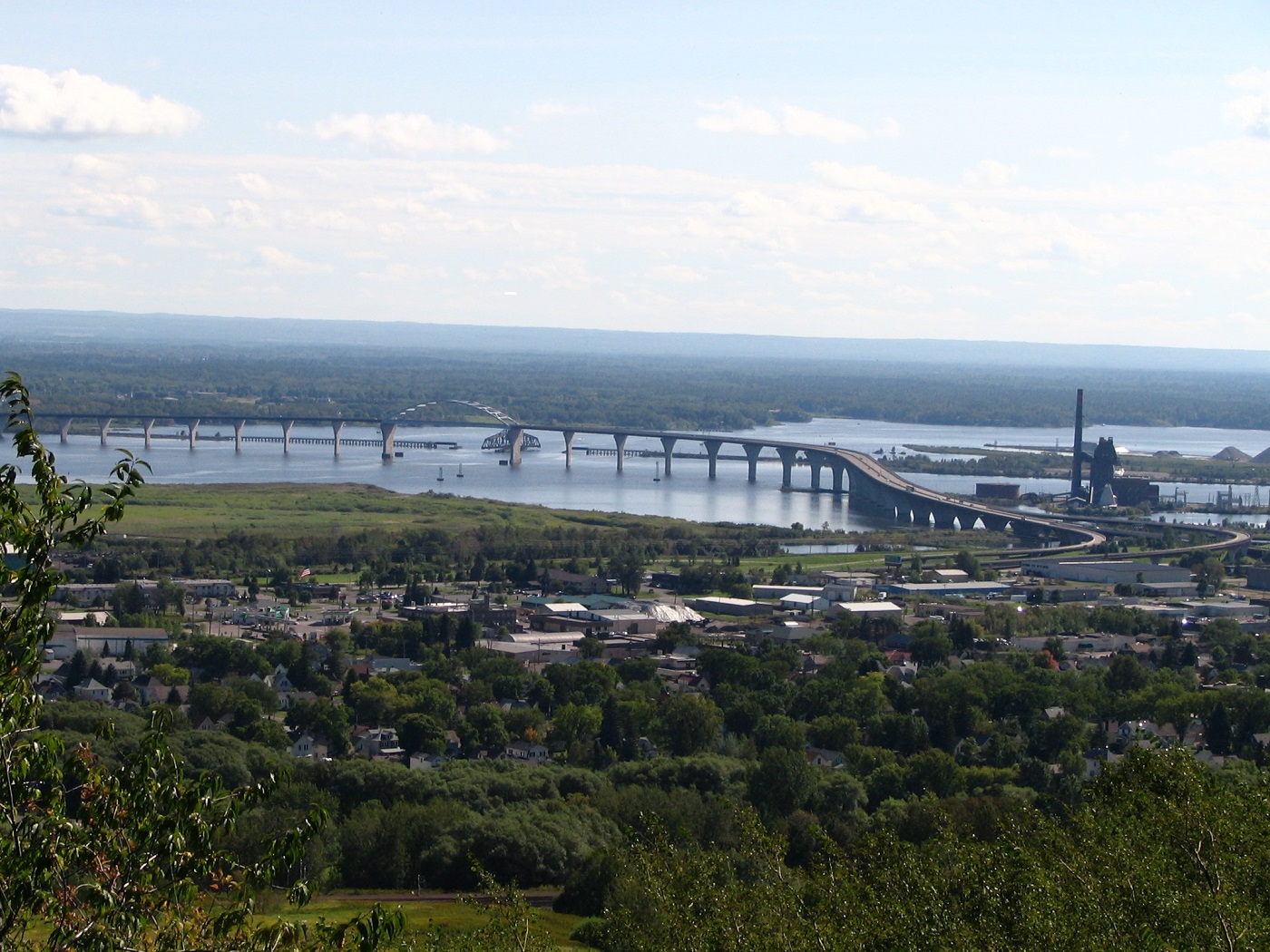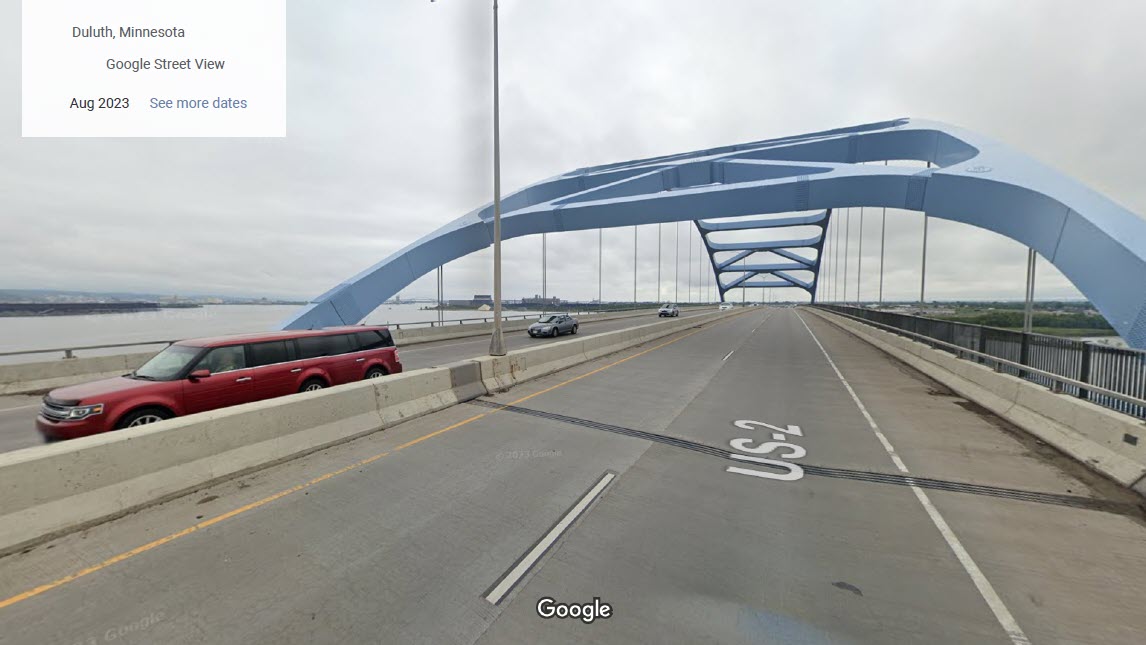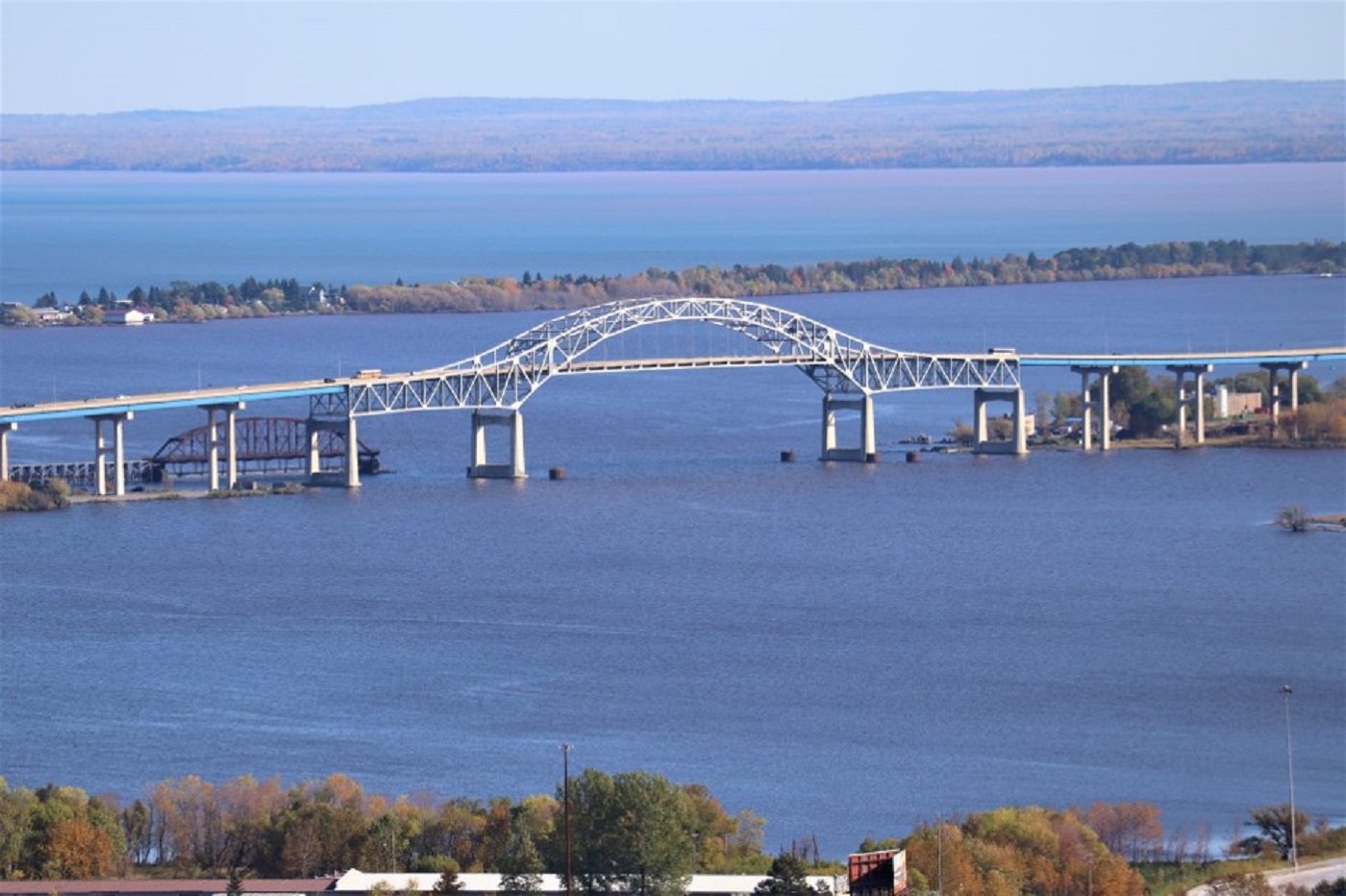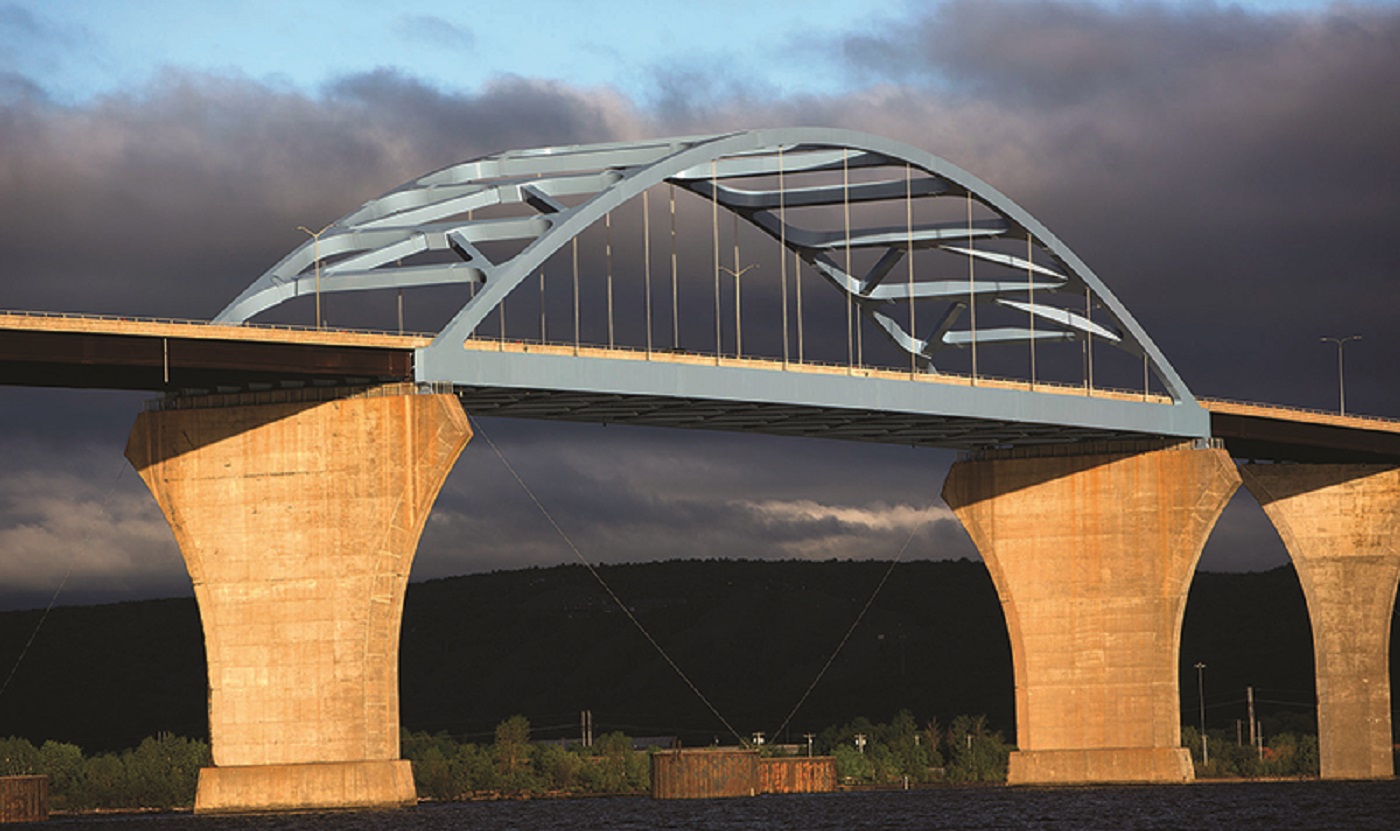Brian Brenner, P.E., F.ASCE, is a professor of the practice at Tufts University and a principal engineer with Tighe & Bond in Westwood, Massachusetts. His collections of essays, Don’t Throw This Away!, Bridginess, and Too Much Information, were published by ASCE Press and are available in the ASCE Library.
In his Civil Engineering Source series More Water Under the Bridge, Brenner shares some thoughts each month about life as a civil engineer, considering bridge engineering from a unique, often comical point of view.
The Richard I. Bong Memorial Bridge connects Duluth, Minnesota, to Superior, Wisconsin. It crosses St. Louis Bay at the western head of Lake Superior. It is one of two vehicular crossings directly connecting the cities, the other being the John A. Blatnik Bridge. The Richard I. Bong Memorial Bridge is about 2 1/4 miles long. It features a tied-arch main span of 500 feet crossing the busy shipping channel, connected on both sides by a series of beam bridge approach spans. The channel provides access from the St. Lawrence Seaway and the Great Lakes to Duluth’s large inland port.
 Douglas J. McLaughlin
Douglas J. McLaughlin The bridge was named after Richard Ira Bong. Mr. Bong was a heroic pilot in the U.S. Army Air Corps (forerunner to the Air Force) during World War II who was also renowned as an ace marksman. The bridge was originally to be named “Arrowhead Bridge” after the original low-level wood trestle the new bridge replaced. Eventually, it was decided to honor the late pilot. Also, there is some thought that the “Richard I. Bong Memorial Bridge” is a name that is a little bit more laid back and chill than the “Arrowhead Bridge,” which is more aggressive.
The Richard I. Bong Memorial Bridge is a long crossing, and sometimes drivers from Superior (see Note 1 below) will get fatigued while driving across it. After such a long trip, those who get the munchies can find a variety of food shops and restaurants on both shores. Those needing to work off some steam can visit a trampoline park north of the bridge in Duluth.
Another way to address fatigue when driving across the bridge is to wear comfortable shoes. Lightweight “Mary Jane” loafers are available at the Duluth Trading Post. These moccasins are considered to be an excellent choice when crossing the Richard I. Bong Memorial Bridge.

The bridge opened in 1985 after three years of construction. In keeping with its era of design and construction, engineers did not specify a jointless deck. Instead, the bridge includes joints between many of its spans (see Note 2 below). The bridge superstructure was rehabilitated in 2014-15. Work included replacing 18 modular expansion joints and six strip seal joints. The deck was repaired, and the steel arch superstructure repainted. The bridge has a pedestrian walkway on the west edge of the deck. Pedestrians can leisurely cross the spans to observe the joints.

The bridge has many piers founded in the bay. These submerged structures help to support aquatic life by providing microhabitats and shelter. This function is an artificial version of natural reef habitats. Lake Superior does not have tropical coral reefs, but underwater freshwater reefs can be found around the Great Lakes. Some of these reefs have become contaminated by industrial and mining processes over time. Large dredging projects have helped to remove contamination. One project is at Buffalo Reef. The project seeks to remove tailing sands from copper mining that covers the reef cobbles and impacts fisheries. Closer to the Richard I. Bong Memorial Bridge, natural underwater reefs are sometimes referred to by the nickname “reefers” (see Note 3).
The Richard I. Bong Memorial Bridge is a key industrial route, but it is perhaps less important for recreational use. However, recreational use has increased. Substantial recreational use increase was supported by Minnesota legislative action on Aug. 1, 2023. However, recreational use in Wisconsin has received less support. Therefore, pedestrians observing the joints on the bridge walkway may need to stop at the Minnesota border before crossing into Wisconsin.
The rehabilitation of the Richard I. Bong Memorial Bridge was completed before the start of a much larger project, a planned replacement of the nearby Blatnik Bridge. The older Blatnik bridge opened in 1961. It features an above-deck arch truss with a main span of 600 feet. This structural type is a smaller version of the main span of the former Key Bridge in Baltimore. Concerns about the Blatnik Bridge’s condition include advancing deterioration, limited pier protection, and the overall strength of truss gusset plates. As the bridge aged, annual maintenance costs were increasing. MnDOT and WDOT determined that full replacement was the best approach, and the agencies received substantial federal funding for the project.

The replacement project is expected to be procured by a design-build contract starting in 2026, with the current project value estimated in the range of $1.8 billion. Based on the preliminary design, the preferred option is for the new bridge to be built at the location of the older one. The existing Blatnik bridge will be closed and demolished. This approach is thought to be the most cost-effective, and it simplifies overall construction staging issues. However, to keep traffic moving, a key part of the plan is to divert traffic to the remaining bridge.
The Richard I. Bong Memorial Bridge is a prominent crossing at the western edge of Lake Superior that has served its residents well for many decades. It is one of the longest bridges in both Wisconsin and Minnesota, but sometimes travelers find it challenging to use its lengthy official name. So they simply refer to it as the “Bong Bridge.”

https://www.ayresassociates.com/project/bong-memorial-bridge-rehabilitation/
Notes
Note 1
Superior, Wisconsin, is a well-regarded city.
Note 2
The climate at the site features a wide temperature range, requiring design for substantial temperature movements in the joints. Although the area may be cold during much of the year, summer days can be very hot. On those days, the bridge experiences smokin’ hot joints.
Note 3
OK, I made that one up. Underwater reefs are not referred to as “reefers.” However, to demonstrate the idea that one can find results on the internet for almost any topic, this aquarium discussion thread, “When Do You Consider Yourself a Reefer,” suggests the nickname “Reefer” for one who is overly enthusiastic in aquarium maintenance.
More Reading
“When is a Bridge a Bong?," by Mariez Huikov, in Marie’s Meanderings, posted May 17, 2017
Huikov writes:
“Although the name is a nice tribute to a local war hero, the people who thought up the name HAD to know it would get shortened to just “Bong Bridge” or just “Bong” in the local vernacular. After all, we have another bridge that spans the same body of water, which is named after John A. Blatnik. Everybody just calls it the “Blatnik.”
“Take the Blatnik to Superior,” we say. Now we can also say, “Take the Bong to Superior.” Most locals know that won’t get you into trouble with the law.
“It’s just such a questionable name. I can’t believe it got through the transportation department’s approval process. But Richard Bong must have had a big fan club that overwhelmed common sense when it came to bridge names.
“We even have a Bong Museum. But it doesn’t contain what you think it might. Not even one. I know. I checked.”
References
“Restoring Buffalo Reef in Lake Superior”
https://www.fishsens.com/ecologists-work-to-restore-lake-superior-reef-for-native-fish/. Accessed June 2024.
“A History of the Bong Bridge Linking Duluth and Superior”
https://newstribuneattic.wordpress.com/2018/04/09/a-history-of-the-bong-bridge-linking-duluth-and-superior/. Accessed June 2024.
“The Richard I. Bong Memorial Bridge”
https://en.wikipedia.org/wiki/Richard_I._Bong_Memorial_Bridge. Accessed June 2024.
“I-535 Blatnik Bridge” MnDOT project website
https://www.dot.state.mn.us/d1/projects/blatnik-bridge/. Accessed June 2024.
“Bong Memorial Bridge Rehabilitation, South Approach & Intersection”
https://www.ayresassociates.com/project/bong-memorial-bridge-rehabilitation/. Accessed June 2024.



